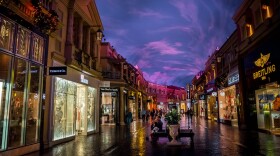One of the toughest projects any city can undertake is lifting up a blighted area. The city of Las Vegas has done it before, to some degree; along with a big boost from the late Zappos boss Tony Hsieh, East Fremont is the bar and restaurant core downtown and continues to grow. It’s also happening in downtown’s Arts District.
But can it happen in Las Vegas’ Historic Westside? It’s roughly bordered by Rancho Drive to the west, Bonanza Road to the south, Carey Avenue to the north and Interstate 15 to the east.
It’s historic, in part, because until the 1960s, casinos allowed black workers but not Black customers; and until 1971, housing codes mostly kept Black residents from living anywhere else. In response, people living there formed their own community, their own businesses, their own jobs.
Over time, though, kids grew up, got better jobs, were allowed to live where they wanted, and moved out. And today, the area struggles.
Now, a group, partnering with civic and university researchers, is trying to change that.
Lizette Guillen is the director of community services and administration for Nevada Partners, which a week ago held an event to kick off an effort to lure investment to the area. She joined State of Nevada host Joe Schoenmann for more, along with Las Vegas Councilman Cedric Crear and UNLV's Vice President of Economic Development Bo Bernhard.
Nevada Partners is the lead of the initiative, which is funded in part by $2.1 million from the Build Back Better Act.
(Right: From L to R: State of Nevada host Joe Schoenmann, Councilman Cedric Crear, Bo Bernhard and Lizette Guillen)
“And really, the mission is to break the generational cycle of poverty,” Guillen said.
One of the ways they can do this is tap into small businesses. With several partners, they’ve been piloting a start-up initiative to help entrepreneurs in the Westside who may not have the means to start their own business. They help the business owner create a plan, website and show them how to build financials.
Each quarter, they highlight these businesses at the Westside Market.
“I’ve been able to see the growth that’s happened in the Westside, the collaboration that’s continuing to grow, and it’s a beautiful thing,” she said. “And now there’s new developments coming, the progression that’s happening, the growth within the community, we’re starting to see people move back into the Westside.”
She said you can see some of this change along Lake Mead Boulevard, D Street and 8th Street.
But revitalization projects are not easy; they don’t happen overnight. East Fremont in downtown Las Vegas has taken a decade, and the Arts District has taken a few years longer.
Crear was born and raised in the Westside, and still lives there.
“There’s no doubt about it, we have a long way to go,” he said. “But we are making a lot of progress.”
He noted the Historic Westside Legacy Park, which opened last December. The city and community partners are also working on a future technology center with Cox, and next year, they hope to break ground on their workforce development center at Jefferson and D streets, a partnership with College of Southern Nevada.
“We are making a lot of progress in a very short period of time,” Crear said. “And it doesn't seem like things happen overnight, which they don't, it's government, and that's unfortunate. In the private sector, you can move a lot quicker, faster, more nimble, probably more affordably. But in the public sector, believe me, we are making tremendous strides in a very short period of time.”
UNLV is involved on the research and teaching side, said Bernhard.
“What we'll be doing is looking at the ways in which we can actually diversify the tourism industry itself to make it more robust, more resilient,” he said. “You might well enjoy going to Bedford-Stuyvesant, you might well enjoy heading downtown to Harlem and taking in some of the cultural brilliance of that community. What if that was something that happened here in Las Vegas? That should be happening in Las Vegas.”
He said you can look at people like Sandra Douglass Morgan, the new Las Vegas Raiders team president, or Craig Billings, who runs the Wynn hotel-casino: “these are folks from the Clark County School District who grew up here, understanding this place in a different way,” he said.
As the university partner, he said they’ll be looking at the 100-year plan and the specific sub-plans to see how diversification of tourism can play out in the Westside.
Crear also shared the appeal of redeveloping the community:
“People are seeing things happening. They want to be a part of the core, a majority of people like living in the core of the city. My wife and I came back when my parents passed, and we took over our home that I grew up in. We made a big investment into our home because we wanted people to see that you can live in this community. I can raise my two daughters, you can have a nice place and you can prosper in this community. So, it takes that as well. I don't think we're going to have a problem finding people who are going to want to come into the Historic Westside. Two years from now, five years from now, 10 years from now, it's gonna look completely totally different. People buy into that, and I think that's important.”
Bo Bernhard, vice president of economic development, UNLV; Cedric Crear, city councilman, Las Vegas; Lizette Guillen, director of community services and administration, Nevada Partners











